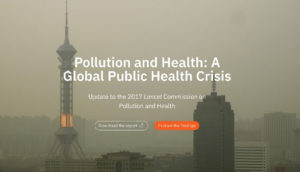
Five years ago, the landmark report from the Lancet Commission on Pollution and Health brought the issue of pollution to the world’s attention. For the first time, the report quantified the true toll of pollution on the human population. Approximately 9 million people are killed by pollution each year. This corresponds to 1 in 6 deaths worldwide. The 2022 followup report, Pollution and health: a progress update, reveals that this alarming toll has not decreased, and pollution remains the most significant environmental risk factor for disease and premature death, with deaths caused by toxic chemical pollution (including lead) increasing 66% since 2000.
“The health impacts of pollution remain enormous, and low- and middle-income countries bear the brunt of this burden. Despite its enormous health, social and economic impacts, pollution prevention is largely overlooked in the international development agenda,” says lead author Richard Fuller, Founder and CEO of Pure Earth and Co-Chair of the Global Alliance on Health and Pollution (GAHP).
While the initial pollution commission report reached over 2 billion people, journalists from over 800 global news outlets reported on these latest findings, reaching over 1.5 billion people in more than 40 countries. They are raising the alarm about this global threat, and this growing awareness about the dangers and toll of pollution–which causes more deaths than HIV/AIDS, TB, and malaria combined–is crucial. The two reports have set the wheels in motion. Pollution can no longer be ignored. The world is paying attention. Action from the world’s decision makers now needs to follow, and ongoing focus on the issue is integral to making the changes necessary to solve pollution.
In fact, increased awareness over the years may have played a part in moving the needle on pollution action. The updated report notes that progress has been made in addressing traditional sources of pollution (household air pollution from solid fuels and unsafe water), which has declined since 2000. However, this decrease in deaths from traditional pollution has been offset by a substantial increase in deaths from exposure to modern industrial pollution – such as ambient air pollution, lead pollution, and other forms of chemical pollution – across all regions over the past 20 years. Lead, in particular, remains a major yet underestimated health threat. Pure Earth’s report with UNICEF, The Toxic Truth, found that 800 million children, or 1 in 3 children worldwide, are lead-poisoned.
As a global nonprofit focused on the issue of pollution since 1999, Pure Earth is spearheading the movement to solve this growing modern industrial pollution problem, with a focus on lead and mercury. Working with partners such as the Global Alliance on Health and Pollution, Pure Earth is bringing on-the-ground fieldwork, paired with strategic solutions, to work with governments and other international and local partners to help make a difference.
Pollution should be regarded with the same importance as other global issues such as biodiversity loss and climate change, as all of these factors are interconnected through complex global systems. Yet pollution control receives little attention and resources from international development assistance and global philanthropy. This must change. These two important reports show how the world can go forward.
This post is by Francesca Greco, a Sustainability Studies major approaching her senior year at Stony Brook University.
Learn more:
Briefing on pollution progress report at NYU’s School of Global Public Health draws nearly 300 participants with panel of experts, The Pollution Blog, May 2022
Explore the report from the Lancet Commission on Pollution and Health, 2017
Explore “Pollution and health: a progress update,” published in the Lancet Planetary Health, 2022



